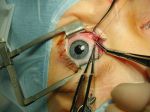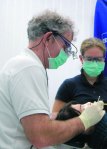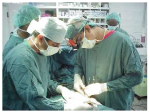 Is magnification really, really necessary for successful strabismus surgery? May be not….. Does magnification benefit the surgeon who performs strabismus surgery? Yes!!
Is magnification really, really necessary for successful strabismus surgery? May be not….. Does magnification benefit the surgeon who performs strabismus surgery? Yes!!
Advantages of Magnification
The surgeon sees the anatomy in more detail in the operative field – enabling more focused attention to finer detail – and contributing to:
- Accurate suture placement
- Awareness of small vessels making it easier to control bleeding
- Accurate identification of tissue layers
- Better visualization of sutures and needles
- Accurate needle placement, enabling a shallow “scleral tunnel” – avoiding scleral perforation
Methods to Achieve Magnification with Loupes
- Power 2.5x to 4.5x (2.5 okay for “younger eyes” but eventually 3.5x to 4.0x is the choice for older surgeons)
- Working Distance + 16″
- A light mounted on a head band and placed between the eyepieces of the loupe is an option many surgeons prefer – this light is especially useful for working in a “hole” such as when doing orbit surgery.
Types of Loupes
- A headband mounted light is a very useful adjunct to loupe magnification in that it improves the view when working in a “hole” and in cases where the surgeon’s or the assistant’s head blocks the fixed operating lights.
- Spectacle mounted loupes are the most popular. They should include distance correction and may have a small bifocal add.
- Presbyopic surgeons benefit from a small bifocal to see at near when looking around loupes
- Head band mounted loupes may be used while the surgeon wears spectacles. They may also be used by several different surgeons. Most surgeons who use loupes purchase the spectacle mounted type.
Want to know more or order magnification loupes? Contact AdmetecVision at www.admetec-vision.com, or call us at our toll-free number: 1-888-670-5063. Prefer to email? You can reach us at contact@admetec-vision.com.
Ready to make your purchase? You can order now online!
(Image courtesy of Wikipedia)









